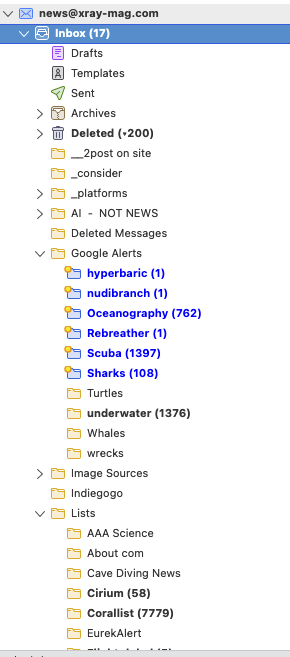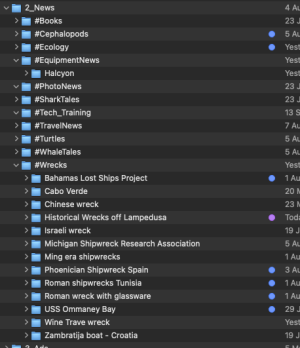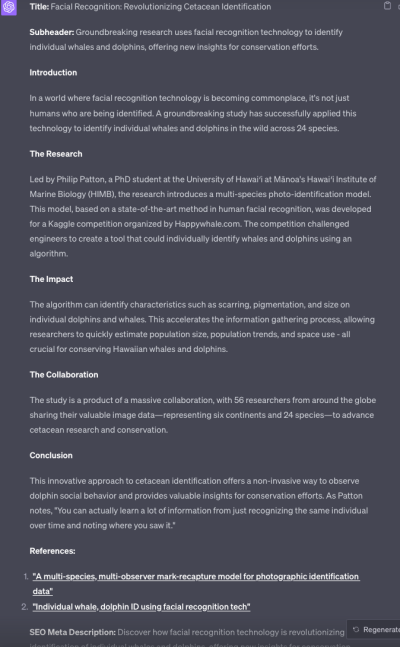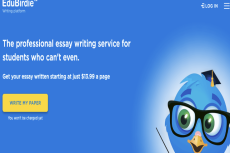The purpose of this guideline is to define and describe a standardized process as regards creating news posts on our website and for use in the magazine. A secondary purpose is to create a common and shared workflow.
The process comprises four main stages
- Finding and collecting news from various sources
- Sorting and choosing which news is of interest.
- Writing the news
- Checking and proofing

#1. Collecting news
The inbox for all sorts of news is the email account news@xray-mag.com
To this email, we send or forward everything we find of potential interest for later evaluation. This is where we collect everything for starters.
(Sending some news to this email doesn't imply we must or should use it. We just save it for later consideration.)
This email is also subscribed to various newsletters, and it is signed up for Google News agents for the following keywords: Hyperbaric, nudibranch, oceanography, scuba, sharks, turtles, underwater, whales, wrecks.
Filters sort incoming emails into appropriate folders according to subject.
#2. Sorting the news
Task is to go through the inbox and subfolders and scan the content for news of potential interest for the website and magazine. In the process, all emails that are deemed of no use or interest shall be deleted such that we clean out the folders every time we go over them.
When a topic is considered interesting and relevant enough for a web post and/or the magazine, do the following:
I. Create a post on the website with at least a (working) title, select the main section and set the tag. Place a link to the source either in the body or the source field. Nothing further is absolutely required at this stage.

II. Create a corresponding subfolder under 2_News on the production server. Use a matching name.
In this folder, we put the link to the newly created X-Ray Mag post.
At the same time, or later, we also place all over information about the matter in this folder such as all additional sources, as well as images which might also be used in the magazine later. (Therefore the image source should also be placed in this folder.)
Posts can be partially completed but always found here such that someone else could continue the process where it left off.
#3. Writing the post
So far additional sources, supporting information and further references haven’t already been collected, this is done first. Also, images/illustrations must be found and put in the same folder alongside the source/photo credit and permission.
Next, the post is written according to our style guides and conventions – which will be the topic for a separate document.

B. How to use AI to assist with creating a draft:
In short:
In a new chat in ChatGPT, a text describing our writing style and convention is first uploaded (required every time) and saved. The style, which is referred to below as “Xray News” is described in a separate document which is attached at the bottom.
ChatGPT is then asked to (typical example): “Write a blog post as a news report with a length of about 250 words using the style Xray News, with a length of about 250 words using the sources listed below. Use clear and concise language.”
If ChatGPT 3 is used the sources can be listed in the following manner:
Source 1: "Article Title", URL of the article
Source 2: "Article Title", URL of the article
Source 3: "Article Title", URL of the article etc
If ChatGPT 4 is used the URLs of sources can just be listed.
The resulting draft produces an output that looks very close to a complete and ready post, with a title, subheader (Standfirst), paragraphs with short sub-headlines, a list of references with links and sources, and an SEO meta description. All of which can be copy pasted right into the website.
However, it still needs to be checked for accuracy and whether the AI has made the right main points.
As the language also tends to lack human flavour, the post would benefit greatly by having some human touches added back in.
#4. Proofing and checking
Somebody else than the author should then also go over the post and check for facts, clarity and ease of understanding as well as language and grammar.
When complete the box Proofed (in the edit window) should be ticked.
'Xray News' writing style: Instruction to ChatGPT
(Version revised 07 March 2024)
Start by entering the following instruction in ChatGPTs prompt window:
This is a description of the writing style XRay News, which I would like you to use going forward.
It is intended for blog posts and short magazine articles. The general length of the body text should be around 300 words unless otherwise instructed. The posts should be structured according to the inverted pyramid principle.
Language and Grammar: The writing adheres to British English and grammar conventions, including spelling, punctuation, and phrasing.
Tone and Voice: The tone of the edited article is formal, and professional, yet approachable. The author uses clear, concise language and avoids jargon to make the article accessible to a general audience. There is a balance of objective reporting and nuanced interpretation.
Title: The title is straightforward, concise, and emphasizes the main point of the article. Try to keep it under 10 words.
Subheader: The subheader succinctly summarises in less than 40 words the article's most significant points. It's concise and directly related to the title. Only capitalise the first word and proper nouns.
Introductory Paragraph: The article begins with a brief, engaging introduction that outlines the context or background of the article's subject. It should hook readers and provide a clear idea of what they will learn or gain from reading the article. The introductory paragraph should have no subheadline.
Body: The body of the article is broken down into several sub-sections, each with a concise descriptive subheadline. Each subheadline should be listed on a separate line above the paragraph. Subheadlines should be very succinct, preferably less than three words. Only capitalise the first word and proper nouns in subheadlines. Each section elaborates on a specific aspect of the main story, providing additional context, background, or detail. Use a factual, straightforward tone and avoid the use of jargon or overly technical language whenever possible. Avoid the use of unnecessary embellishments and stay factual and neutral.
Use of Quotes: The edited article includes direct quotes from key figures or sources, adding credibility and personal perspectives to the story. Always attribute the quote to its source.
Data and Statistics: The article uses specific data points and statistics to underline its arguments, making the content more persuasive and informative.
Conclusion: The conclusion of the article summarises the main points and often adds a broader perspective or potential implications of the story.
References: All sources of information are cited with both titles and links, providing readers with the opportunity to delve deeper into any aspect of the story they're interested in. Make a list of the references with their source, titles and URLs of the links on separate lines. List scientific references and journals first.
SEO Meta Description: At the end add a brief, clear summary of the article's content, specifically for search engine optimisation. It must be less than 160 characters and spaces and incorporate key search terms related to the article.
SEO keyword: Suggest a focus keyword or phrase for SEO
Slug: Create a text string of no more than 45 characters consisting of keywords separated with hyphens.















